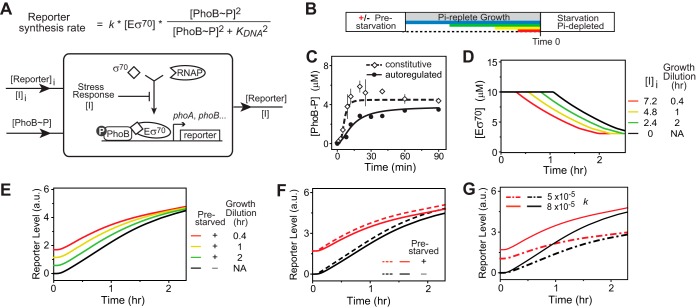FIG 7.
A model of stress response explains the homeostasis of reporter levels. (A) Model scheme. PhoB-regulated reporter activity is a function of the concentration of PhoB∼P and of the effective concentration of RNAP-σ70 complex (Eσ70), with the rate equation shown. Parameter k describes the gene-specific factors, such as promoter strength and translation efficiency, that determine the protein expression level. Stress response is represented with an arbitrary stress factor, I, that decreases the concentration of Eσ70 (see Modeling Details in the supplemental material). Reporter output is dependent on the input of [PhoB∼P] as well as on the history-related initial levels of I and reporter expression. (B) Illustration of timeline. Different growth dilution times are shown in different colors. (C) Profiles of PhoB∼P input. In vivo phosphorylation kinetics of PhoB have been quantified based on previous Phos-tag analyses of intracellular PhoB∼P (17, 28) for constitutively expressed phoBR in strain RU1616 and autoregulated phoBR in the WT strain. Fitted Hill curves were used for PhoB∼P inputs and represent the boundary of PhoB phosphorylation kinetics with the initial concentration of PhoB at the high level (dashed line) and the low level (solid line). (D) Modeling the dependence of [Eσ70] on prestarvation. Prestarvation increases the concentration of I, and different growth dilution times in Pi-replete medium result in different initial concentrations of I ([I]i). Higher [I]i levels cause an earlier entry into the stationary phase that decreases [Eσ70]. (E) Homeostasis of reporter output. Different Eσ70 dynamics (shown in panel D) result in converging levels of reporter output regardless of the time spent in Pi-replete medium. (F) Simulation of reporter output affected by PhoB∼P profiles. Dashed lines represent data modeled with the PhoB∼P kinetic profile from RU1616, while solid lines indicate data modeled with the WT PhoB∼P profile described in the panel B legend. (G) Effect of gene-specific parameter k on output homeostasis for cells with (red) or without (black) prestarvation.

